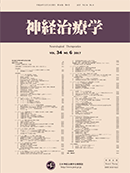Volume 40, Issue 4
Displaying 51-88 of 88 articles from this issue
-
2023 Volume 40 Issue 4 Pages 568
Published: 2023
Released on J-STAGE: November 27, 2023
Download PDF (175K)
-
2023 Volume 40 Issue 4 Pages 569
Published: 2023
Released on J-STAGE: November 27, 2023
Download PDF (268K) -
2023 Volume 40 Issue 4 Pages 570
Published: 2023
Released on J-STAGE: November 27, 2023
Download PDF (200K) -
2023 Volume 40 Issue 4 Pages 571-574
Published: 2023
Released on J-STAGE: November 27, 2023
Download PDF (763K) -
2023 Volume 40 Issue 4 Pages 575-579
Published: 2023
Released on J-STAGE: November 27, 2023
Download PDF (635K) -
2023 Volume 40 Issue 4 Pages 580-584
Published: 2023
Released on J-STAGE: November 27, 2023
Download PDF (468K) -
2023 Volume 40 Issue 4 Pages 585-587
Published: 2023
Released on J-STAGE: November 27, 2023
Download PDF (370K) -
2023 Volume 40 Issue 4 Pages 588-591
Published: 2023
Released on J-STAGE: November 27, 2023
Download PDF (596K)
-
2023 Volume 40 Issue 4 Pages 592
Published: 2023
Released on J-STAGE: November 27, 2023
Download PDF (238K) -
2023 Volume 40 Issue 4 Pages 593
Published: 2023
Released on J-STAGE: November 27, 2023
Download PDF (207K) -
2023 Volume 40 Issue 4 Pages 594-597
Published: 2023
Released on J-STAGE: November 27, 2023
Download PDF (840K) -
2023 Volume 40 Issue 4 Pages 598-605
Published: 2023
Released on J-STAGE: November 27, 2023
Download PDF (2488K) -
2023 Volume 40 Issue 4 Pages 606-609
Published: 2023
Released on J-STAGE: November 27, 2023
Download PDF (348K)
-
2023 Volume 40 Issue 4 Pages 610
Published: 2023
Released on J-STAGE: November 27, 2023
Download PDF (310K) -
2023 Volume 40 Issue 4 Pages 611-616
Published: 2023
Released on J-STAGE: November 27, 2023
Download PDF (1937K) -
2023 Volume 40 Issue 4 Pages 617-621
Published: 2023
Released on J-STAGE: November 27, 2023
Download PDF (2377K) -
2023 Volume 40 Issue 4 Pages 622-624
Published: 2023
Released on J-STAGE: November 27, 2023
Download PDF (376K) -
2023 Volume 40 Issue 4 Pages 625
Published: 2023
Released on J-STAGE: November 27, 2023
Download PDF (156K)
-
2023 Volume 40 Issue 4 Pages 626
Published: 2023
Released on J-STAGE: November 27, 2023
Download PDF (255K) -
2023 Volume 40 Issue 4 Pages 627-632
Published: 2023
Released on J-STAGE: November 27, 2023
Download PDF (1430K) -
2023 Volume 40 Issue 4 Pages 633-636
Published: 2023
Released on J-STAGE: November 27, 2023
Download PDF (1052K) -
2023 Volume 40 Issue 4 Pages 637-641
Published: 2023
Released on J-STAGE: November 27, 2023
Download PDF (2160K) -
2023 Volume 40 Issue 4 Pages 642
Published: 2023
Released on J-STAGE: November 27, 2023
Download PDF (172K)
-
2023 Volume 40 Issue 4 Pages 643
Published: 2023
Released on J-STAGE: November 27, 2023
Download PDF (272K) -
2023 Volume 40 Issue 4 Pages 644
Published: 2023
Released on J-STAGE: November 27, 2023
Download PDF (186K) -
2023 Volume 40 Issue 4 Pages 645-649
Published: 2023
Released on J-STAGE: November 27, 2023
Download PDF (843K) -
2023 Volume 40 Issue 4 Pages 650
Published: 2023
Released on J-STAGE: November 27, 2023
Download PDF (190K) -
2023 Volume 40 Issue 4 Pages 651-653
Published: 2023
Released on J-STAGE: November 27, 2023
Download PDF (348K)
-
2023 Volume 40 Issue 4 Pages 654
Published: 2023
Released on J-STAGE: November 27, 2023
Download PDF (263K) -
2023 Volume 40 Issue 4 Pages 655-658
Published: 2023
Released on J-STAGE: November 27, 2023
Download PDF (435K) -
2023 Volume 40 Issue 4 Pages 659
Published: 2023
Released on J-STAGE: November 27, 2023
Download PDF (203K) -
2023 Volume 40 Issue 4 Pages 660-663
Published: 2023
Released on J-STAGE: November 27, 2023
Download PDF (1453K) -
2023 Volume 40 Issue 4 Pages 664
Published: 2023
Released on J-STAGE: November 27, 2023
Download PDF (163K) -
2023 Volume 40 Issue 4 Pages 665
Published: 2023
Released on J-STAGE: November 27, 2023
Download PDF (180K)
-
2023 Volume 40 Issue 4 Pages 666-669
Published: 2023
Released on J-STAGE: November 27, 2023
Download PDF (1265K)
-
2023 Volume 40 Issue 4 Pages 670-673
Published: 2023
Released on J-STAGE: November 27, 2023
Download PDF (341K) -
2023 Volume 40 Issue 4 Pages 675
Published: 2023
Released on J-STAGE: November 27, 2023
Download PDF (148K) -
2023 Volume 40 Issue 4 Pages 676
Published: 2023
Released on J-STAGE: November 27, 2023
Download PDF (133K)
